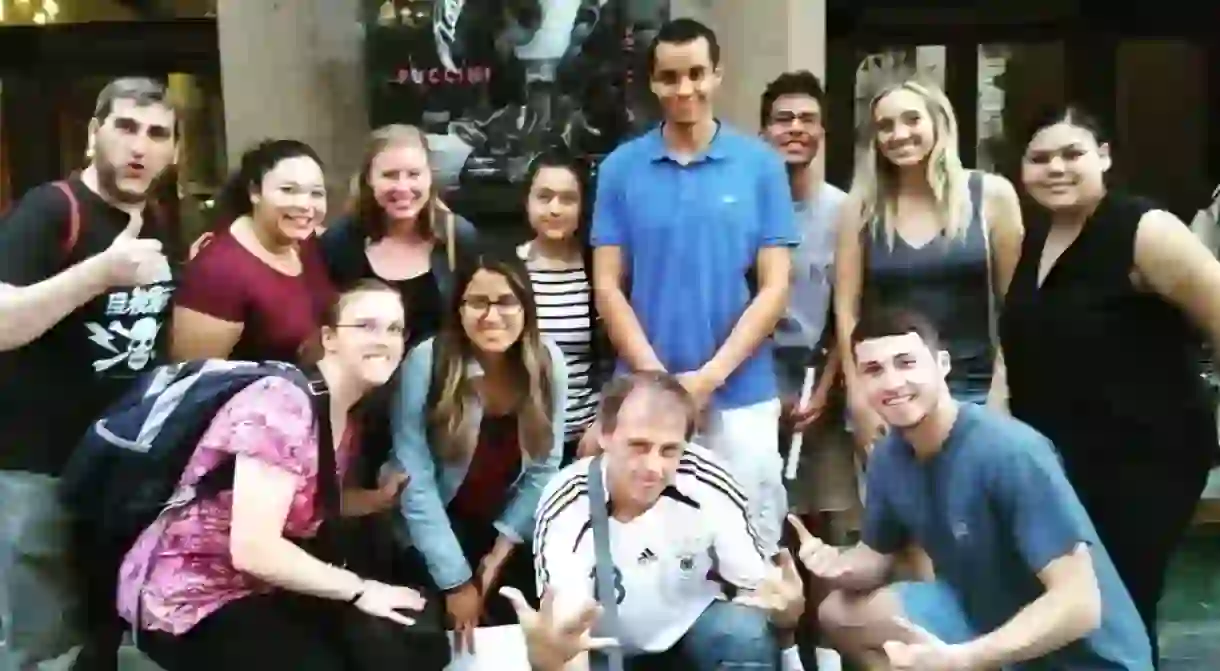Meet the Homeless People Creating Tours for Visitors to Barcelona

Meet Lisa Grace, the woman who founded Hidden City Tours and created jobs for Barcelona’s homeless. These are not your regular city tours however – they don’t talk about the history of the city or take you around the famous sights. No, these tours take you right into the heart of Barcelona’s gritty underbelly and down the backstreets most tourists would never find. Here’s everything you need to know.
Background
Lisa moved to Barcelona in 2004 and worked as a market research consultant, but during the financial crisis in 2012, she lost her job and found herself joining the Spanish dole queue in 2012. While looking for voluntary work in the spring of 2013, Lisa came across Unseen Tours, a social enterprise in London offering homeless walking tours. This gave her the idea to replicate the idea in Barcelona – and Hidden City Tours was born.

Outside the famous Liceu Theatre on La Rambla, I meet guides Juan and Udo chatting away in German. Udo, I discover is from Stuttgart, and after a series of events found himself homeless on the streets of Barcelona, while Juan is from the south of Spain and was homeless in the city for ten years. While Udo takes the English group, I go with Juan and the Spanish group.
Juan’s Story
Standing on the edge of La Rambla, Juan tells us his story. He was born in the south of Spain in Cadiz, but moved to Germany with his family in the 1970s. When he finished school, he became a plumber, however later he became involved in drugs and even started dealing them too. Eventually he was caught and thrown into prison for two years. Upon his release, he was sent back to Spain – his home country, but a place where he knew no one. In Barcelona he fell into drugs again and found himself living on the city streets for the next 10 years.

Sleeping rough in a romantic garden
Juan moves off the Rambla and down into the side streets. “Have you ever heard of the Romantic Garden?” he asks us. None of us had, even those who had grown up in the city. Juan then leads us into a hotel and through the back into a pretty garden, filled with leafy trees, trickling fountains and wooden benches. “This is a public garden,” he tells us, but because the lift to get up here is broken, you can only access it through the hotel. I used to have trouble finding somewhere to sleep because the police would always come and wake me up and tell me to move on, but then someone told me about this place. Here it was absolutely quiet and I could sleep in peace.”

The homeless hangout of Plaça Reial
Juan leaves the garden and shows us the street corner where he used to buy drugs, and the narrow dark alleyway, where he had once stolen from a drunk tourist. Next he takes us on to Plaça Reial, the huge palm-tree filled square just off the Rambla. “There used to be a soup kitchen right through that archway,” he says pointing to one of the streets off the square, “and hundreds of homeless people would queue up here, right through the middle. The authorities didn’t like that though, so they moved the kitchen. It’s still a popular homeless hangout though,” he says indicating to a man lying on the floor by the bin, another dishevelled on a bench, and a lady with torn clothes sitting in a wheelchair.

The tour continues on and Juan shows us other drug dealing corners, an an old building drug users used to occupy because it had no staircase, and one of the oldest brothels in the city, which had just been torn down last year.
We now cross La Rambla again and into Raval. Juan shows us a public building, where homeless people and drug addicts can go to take their drugs safely. “Nurses administer the drugs for them to make sure they use clean needles and inject the correct amounts. They also make sure they’re on hand to stop anyone overdosing. This place has saved a lot of lives.”
We pass into a narrow street and Juan points to a nondescript doorway with the name ‘El Chiringuito de Dios’ above. This is the small soup kitchen which took Juan in and changed his life around. It’s also the place where he met Lisa and found out about Hidden City Tours.

Juan finds home
Juan then points to a doorway nearby where the glass has been broken and cardboard covers the hole. “I am now an occupier”, he says grinning broadly, taking out his keys and turning the look to prove to us that he is no longer homeless. Because of the tours and the kindness of Wolfgang’s Chiringuito de Dios, Juan is now able to pay rent in a shared apartment. “It’s right next door to a brothel,” he explains “and I get woken up all night by men ringing my bell, confusing it with the wrong apartment, but I’m no longer homeless”. He grins again, proud to have his own place to live.
As we walk back to where the tour began Juan says: “None of us really know what poverty is. I am not truly poor, I have enough food, and I had a choice. Some people in Africa – now they are poor, starving and have no choice”. I can’t help admire Juan for his attitude and enthusiasm. He clearly loves giving these tours and they have helped him completely change his life around.














